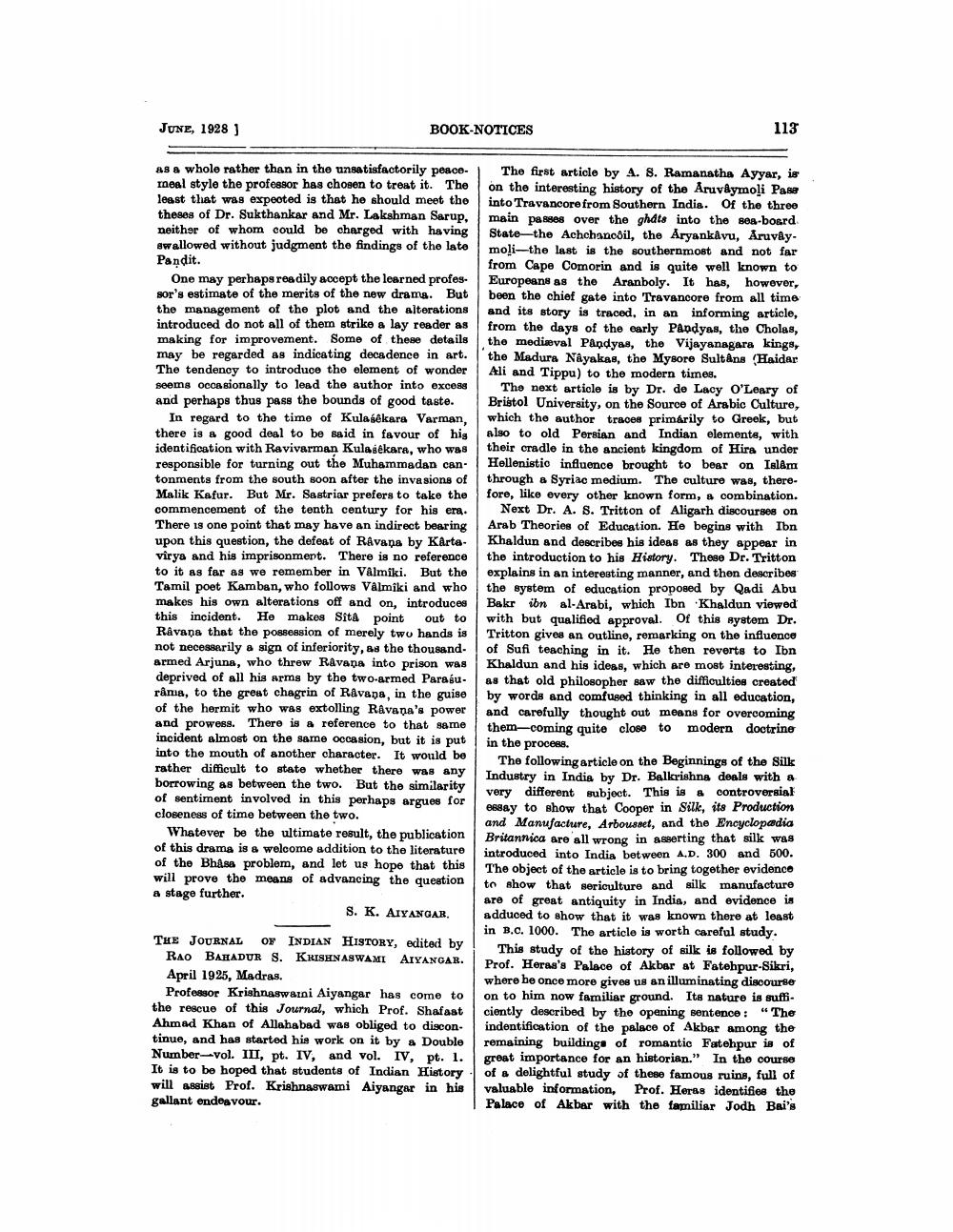________________
JUNE, 1928)
BOOK-NOTICES
113
as a whole rather than in the unsatisfactorily peace-1 The first article by A. S. Ramanatha Ayyar, is real style the professor has chosen to treat it. The on the interesting history of the Aruvdymoli Pase least that was expected is that he should meet the into Travancore from Southern India. Of the three theses of Dr. Sukthankar and Mr. Lakshman Sarup. main pages over the ghats into the sea-board neither of whom could be charged with having State-the Achchanobil, the Aryankávu, Aruvây. swallowed without judgment the findings of the late
moli-the last is the southernmost and not far Pandit.
from Cape Comorin and is quite well known to One may perhaps readily accept the learned profes. Europeans as the Aranboly. It has, however, sor's estimate of the merits of the new drama. But been the chief gate into Travancore from all time the management of the plot and the alterations and its story is traced, in an informing article, introduced do not all of them strike a lay reader as from the days of the early Pandyas, the Cholas, making for improvement. Some of these details the medieval PAnda. the ViiavAnABATA kines. may be regarded as indicating decadence in art. the Madura Nayakas, the Mysore Sultana Haidar The tendency to introduce the element of wonder Ali and Tippu) to the modern times. seems occasionally to lead the author into excess The next article is by Dr. de Lacy O'Leary of and perhaps thus pass the bounds of good taste. Bristol University, on the source of Arabic Culture,
In regard to the time of Kulasekara Varman, which the author traces primarily to Greek, but there is a good deal to be said in favour of his also to old Persian and Indian elements, with identification with Ravivarman Kulasekara, who was their cradle in the ancient kingdom of Hira under responsible for turning out the Muhammadan can. Hellenistio influence brought to bear on Islam tonments from the south soon after the invasions of through a Syriac medium. The culture was, there. Malik Kafur. But Mr. Sastriar prefers to take the fore, like every other known form, & combination. commencement of the tenth century for his era. Next Dr. A. 8. Tritton of Aligarh discourses on There is one point that may have an indirect bearing Arab Theories of Education. He begins with Ibn upon this question, the defeat of RAvada by KArta. Khaldun and describes his ideas as they appear in virya and his imprisonment. There is no reference the introduction to his History. These Dr. Tritton to it as far as we remember in VAlmiki. But the explains in an interesting manner, and then describes Tamil poet Kamban, who follows Valmiki and who the system of education proposed by Qadi Abu makes his own alterations off and on, introduces Bakr ibn al-Arabi, which Ibn Khaldun viewed this incident. He makes Sita point out to with but qualified approval of this system Dr. Ravana that the possession of merely two hands is Tritton gives an outline, remarking on the influence not necessarily a sign of inferiority, as the thousand- of Sufi teaching in it. He then reverts to Ibn armed Arjuna, who threw Ravana into prison was | Khaldun and his ideas, which are most interesting, deprived of all his arms by the two-armed Paragu- as that old philosopher saw the difficulties created rânia, to the great chagrin of Råvana, in the guise by words and comfused thinking in all education, of the hermit who was extolling Ravana's power and carefully thought out means for overcoming and prowess. There is a reference to that same them-ooming quite close to modern doctrine incident almost on the same occasion, but it is put in the process. into the mouth of another character. It would be The following article on the Beginnings of the Silk rather difficult to state whether there was any
Industry in India by Dr. Balkrishna deals with a borrowing as between the two. But the similarity
very different subject. This is a controversial of sentiment involved in this perhaps argues for
8888y to show that Cooper in Silk, its Production closeness of time between the two.
and Manufacture, Arbousset, and the Encyclopadia Whatever be the ultimate result, the publication
Britannica are all wrong in asserting that silk was of this drama is a welcome addition to the literature introduced into India between A.D. 300 and 500. of the Bhisa problem, and let us hope that this
The object of the article is to bring together evidence will prove the means of advancing the question
to show that sericulture and silk manufacture a stage further.
are of great antiquity in India, and evidence is S. K. AIYANGAR adduced to show that it was known there at least
in B.C. 1000. The article is worth careful study. THE JOURNAL OF INDIAN HISTORY, edited by
This study of the history of silk is followed by
This RAO BAHADUR S. KRISHNASWAMI AIYANGAR.
Prof. Heras's Palace of Akbar at Fatehpur-Sikri, April 1925, Madras.
where be once more gives us an illuminating discourse Professor Krishnaswauni Aiyangar has come to on to him now familiar ground. Its nature is suffithe rescue of this Journal, which Prof. Shafast ciently described by the opening sentence: “The Ahmad Khan of Allahabad was obliged to discon. indentification of the palace of Akbar among the tinue, and has started his work on it by a Double remaining buildinga of romantic Fatehpur is of Number - vol. III, pt. IV, and vol. IV, pt. 1. great importance for an historien." In the course It is to be hoped that students of Indian History | of a delightful study of these famous ruins, full of will assist Prof. Krishnaswami Aiyangar in his valuable information, Prof. Heras identifies the gallant endeavour.
Palace of Akbar with the familiar Jodh Bai's




